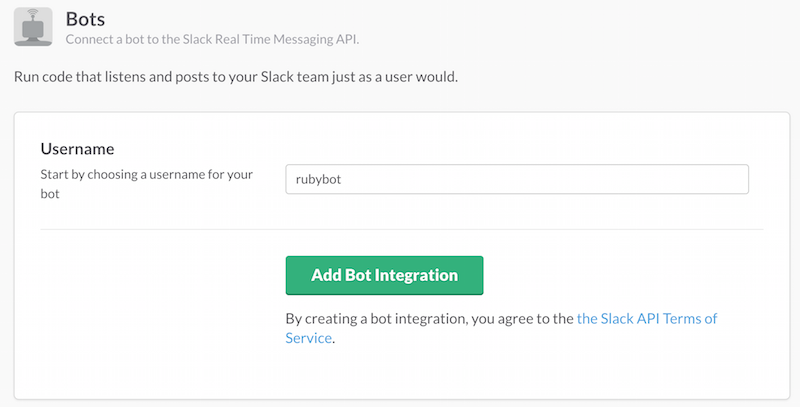A Ruby client for the Slack Web and RealTime Messaging APIs.
Writing a bot? Try slack-ruby-bot instead.
You're reading the documentation for the next release of slack-ruby-client. Please see the documentation for the last stable release, v0.4.0 unless you're integrating with HEAD.
Add to Gemfile.
gem 'slack-ruby-client'
If you're going to be using the RealTime client, add either eventmachine and faye-websocket or celluloid-io. See below for more information about concurrency.
gem 'eventmachine'
gem 'faye-websocket'
Run bundle install.
This is something done in Slack, under integrations. Create a new bot, and note its API token.
Slack.configure do |config|
config.token = ENV['SLACK_API_TOKEN']
endThis sets a global default token. You can also pass a token into the initializer of both Slack::Web::Client and Slack::RealTime::Client or configure those separately via Slack::Web::Config.configure and Slack::RealTime::Config.configure. The instance token will be used over the client type token over the global default.
The Slack Web API allows you to build applications that interact with Slack. For example, send messages with chat_PostMessage.
client = Slack::Web::Client.new
client.auth_test
general_channel = client.channels_list['channels'].detect { |c| c['name'] == 't3' }
client.chat_postMessage(channel: general_channel['id'], text: 'Hello World', as_user: true)See a fully working example in examples/hi_web.
Refer to the Slack Web API Method Reference for the list of all available functions.
You can configure the Web client either globally or via the initializer.
Slack::Web::Client.config do |config|
config.user_agent = 'Slack Ruby Client/1.0'
endclient = Slack::Web::Client.new(user_agent: 'Slack Ruby Client/1.0')The following settings are supported.
| setting | description |
|---|---|
| token | Slack API token. |
| user_agent | User-agent, defaults to Slack Ruby Client/version. |
| proxy | Optional HTTP proxy. |
| ca_path | Optional SSL certificates path. |
| ca_file | Optional SSL certificates file. |
| endpoint | Slack endpoint, default is https://slack.com/api. |
The Real Time Messaging API is a WebSocket-based API that allows you to receive events from Slack in real time and send messages as user.
client = Slack::RealTime::Client.new
client.on :hello do
puts "Successfully connected, welcome '#{client.self['name']}' to the '#{client.team['name']}' team at https://#{client.team['domain']}.slack.com."
end
client.on :message do |data|
case data['text']
when 'bot hi' then
client.message channel: data['channel'], text: "Hi <@#{data['user']}>!"
when /^bot/ then
client.message channel: data['channel'], text: "Sorry <@#{data['user']}>, what?"
end
end
client.start!You can send typing indicators with typing.
client.typing channel: data['channel']You can send a ping with ping.
client.pingThe client exposes the properties of rtm.start upon a successful connection.
| property | description |
|---|---|
| url | A WebSocket Message Server URL. |
| self | Details on the authenticated user. |
| team | Details on the authenticated user's team. |
| users | A list of user objects, one for every member of the team. |
| channels | A list of channel objects, one for every channel visible to the authenticated user. |
| groups | A list of group objects, one for every group the authenticated user is in. |
| ims | A list of IM objects, one for every direct message channel visible to the authenticated user. |
| bots | Details of the integrations set up on this team. |
You can configure the RealTime client either globally or via the initializer.
Slack::RealTime::Client.config do |config|
config.websocket_ping = 42
endclient = Slack::RealTime::Client.new(websocket_ping: 42)The following settings are supported.
| setting | description |
|---|---|
| token | Slack API token. |
| websocket_ping | The number of seconds that indicates how often the WebSocket should send ping frames, default is 30. |
| websocket_proxy | Connect via proxy, include :origin and :headers. |
Note that the RealTime client uses a Web client to obtain the WebSocket URL via rtm.start, configure Web client options via Slack::Web::Client.configure as described above.
See a fullly working example in examples/hi_real_time.
Since the Web client is used to obtain the RealTime client's WebSocket URL, you can continue using the Web client in combination with the RealTime client.
client = Slack::RealTime::Client.new
client.on :message do |data|
case data['text']
when 'bot hi' then
client.web_client.chat_postMessage channel: data['channel'], text: "Hi <@#{data['user']}>!"
when /^bot/ then
client.web_client.chat_postMessage channel: data['channel'], text: "Sorry <@#{data['user']}>, what?"
end
end
client.start!See a fullly working example in examples/hi_real_time_and_web.
Slack::RealTime::Client needs help from a concurrency library and supports Eventmachine and Celluloid. It will auto-detect one or the other depending on the gems in your Gemfile.
This concurrency implementation uses Eventmachine with Faye::WebSocket. Add the following to your Gemfile.
gem 'eventmachine'
gem 'faye-websocket'
Add the following to your Gemfile.
gem 'celluloid-io'
This is an implementation that uses Faye::WebSocket, which uses EventMachine, without actively trying to manage concurrency for you. For example, slack-bot-server manages multiple realtime clients. In order to handle their restarts it wants to control when EM.run is called. The Slack::RealTime::Concurrency::Faye::Socket implementation is identical to Slack::RealTime::Concurrency::Eventmachine::Socket, but without the EM.run call.
Add the following to your Gemfile.
gem 'faye-websocket'
To use the Faye concurrency model or another custom implementation, configure it as follows.
Slack::RealTime.configure do |config|
config.concurrency = Slack::RealTime::Concurrency::Faye
endThis gem is based on slack-ruby-gem, but it more clearly separates the Web and RTM APIs, is more thoroughly tested and is in active development.
See CONTRIBUTING.
Copyright (c) 2015, Daniel Doubrovkine, Artsy and Contributors.
This project is licensed under the MIT License.




